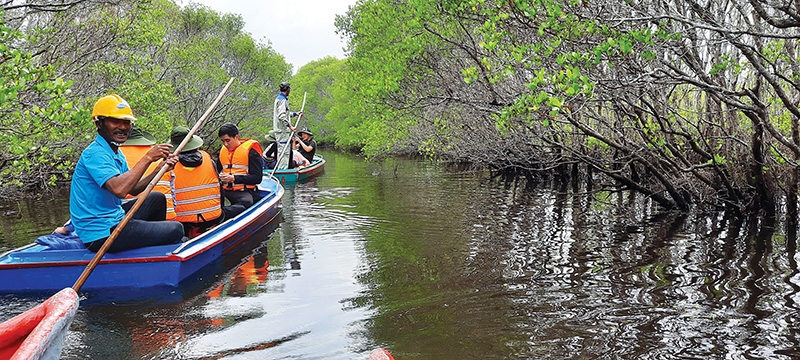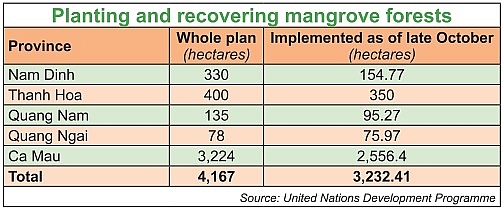
 In The News
In The News
As published in Vietnam Investment Review on 16 Nov 2020
With the central region having suffered from recent weather calamities, inhabitants in the south-central province of Quang Ngai’s Binh Thuan commune have been struggling to make ends meet. However, the lives of many have started to see significant changes on the back of an initiative to grow mangroves to both shield villages from storms and develop eco-tourism.

Sitting at peace on a wooden sampan sailing on the surface of the water, 43-year-old Pham Duy Nghia, gazes adoringly at the mangrove forest in front of him, with the green leaves and tiny white blossoms shining in the sunlight.
Here and there, white storks and a range of other birds are perched on the mangroves, which have been planted in straight lines in an immense lagoon called Bau Ca Cai in Thuan Phuoc hamlet. The scene, in Binh Son district of the south-central province of Quang Ngai, is akin to a beautiful watercolour painting drawn by both humans and nature.
About 10 years ago, Nghia and local residents often caught fish here, which enabled them to make ends meet with an average income of about VND700,000-800,000 ($30-35) per household. However, the area became increasingly polluted, with no fish to catch and the villagers finding themselves in a more precarious position. Many left for big urban areas to earn a living. Elderly people and children became the majority in the village, while some women maintained their livelihoods by raising oxen and planting rice.
“But now, our life has gradually changed and more and more people have begun to come back to the village to live,” Nghia told VIR.
In 2014, the provincial authorities started a mangrove-planting scheme at Bau Ca Cai lagoon, directly facing the sea. However, it was not until in 2016 when a mangrove-planting project was implemented here to expand the scheme that locals like Nghia were able to see positive changes.
“Many local residents and I were engaged in the project as we began to plant the trees in the lagoon. Water became less polluted and now it is clear and fish can be found. The landscape has become a mangrove forest now,” Nghia said while sailing by on the sampan.

Storm-resistant shield
The recent storms which were some of the strongest swept across Quang Ngai and caused significant damage to the livelihoods of hundreds of thousands of households in the province. However, farmers like Nguyen Thi Hai, 53, in Binh Thuan commune, had their homes and fruit trees protected from any sabotage.
“The mangrove forest is useful as it has protected villagers’ houses,” Hai told VIR. “I have a garden of pawpaw plants, which would easily be smashed down by strong wind. However, only several plants have been taken down by the storms.”
Associate professor Le Anh Tuan, from the Research Institute for Climate Change at Can Tho University, said that this mangrove forest has “not only maintained livelihoods for locals, but also played a very important role in responding to climate change, staving off storms and reducing negative impacts.”
The model needs to be expanded in many other localities across Vietnam, Tuan added.
The mangrove-planting project in Binh Thuan commune is part of a wider project to improve the resilience of coastal communities to climate change in Vietnam, funded jointly by the Green Climate Fund (GCF), the Vietnamese government, and the United Nations Development Programme (UNDP).
Mangrove areas create a vital buffer between the sea and coastal communities. GCF funds support plantation and regeneration of approximately 4,000 hectares of mangroves in coastal areas vulnerable to climate change impacts, including the provinces of Nam Dinh, Thanh Hoa, Quang Nam, Quang Ngai, and Ca Mau.
“Coastal forests, especially mangroves, play a vital role in protecting the lives of vulnerable communities from storm surge due to the impacts of natural disasters and climate change,” said Caitlin Wiesen, resident representative of the UNDP in Vietnam.
In recent years, the government has paid great attention to the promulgation of a series of policies to protect and develop mangrove forests as the decline of mangrove forests in terms of soil erosion and deposition became a more critical issue. Such forests have been declining in both quantity and quality due to natural factors such as waves, wind, and storms, and human factors like construction, exploitation, and aquaculture.
“Human factors are the main cause for mangrove forest degradation including illegal exploitation and construction. That is why UNDP works to plant and regenerate mangrove forests in ways that engage local communities with sustainable livelihoods and with local authorities to plan and protect forests,” Wiesen said.
Mangroves are a typical ecosystem of coastal Vietnam and a transition ecosystem between freshwater and marine environments. They play a huge part in the local environment, especially on sea dyke protection, erosion control, land stabilisation, riverbank protection, and reducing the negative impacts of storms, cyclones and wave surges.
Many benefits from the small trees include timber and non-timber forest products, aquatic resources, ecotourism, biofiltration, and coastal protection, especially protection of sea dykes, land consolidation, and accumulation and CO2 absorption.
New means of subsistence
Along with helping locals protect themselves from storms, the mangrove forest has also given them various other benefits, such as income from taking visitors to the forest for a tour.
Before 2019, Nguyen Thi Hai lived on catching fish in the sea. However, since then her family has been engaging in transporting tourists on sampans to the lagoon. Her family now owns three boats.
Her husband, 54-year-old Nguyen Khuong, worked at Germadept International Port in Quang Ngai for many years but has now become an oarsman cum tourist guide.
“On average, this job can give our family about VND6 million ($260) a month,” said Khuong.
Like many other locals, 49-year-old Pham Duy Su, has also become a guide at the lagoon. Before last year he worked at the steel manufacturing complex from Hoa Phat Group in Binh Son district. However, he eventually quit and began to work at the lagoon on his own.
“I am happy with the work of an oarsman,” Su said with a bright smile. “It can give me about VND500,000 ($21.70) a day, tripling that of the salary I got from my previous job.”
According to the commune’s leadership, since the mangrove forest appeared and was developed, Binh Thuan commune’s leadership has established three groups of tourist guides with many sampans which are operated manually in order to protect the environment.
The project has also supported 10 households in the commune with 3,000 breeding sea ducks, medicine, and feed so that they can live well. Another 15 households are also assisted in managing and protecting the forests, and another 40 households in planting and taking care of the mangrove trees.
Pham Duy Nghia and many other residents are even mulling over raising crabs at the lagoon to increase income. Nghia said a volume of 20,000 breeding crabs, worth about VND2 million ($87), can bring about a profit of VND15-20 million ($650-870) after three months, if the business goes smoothly.
“It’s clear that the mangrove forest has changed our life,” Nghia said. “We want the project to further expand the area for planting mangroves and turn this area into a bigger forest, so that we can receive even more tourists.”
Not far from his house, there is a large area of newly-planted mangroves budding out of the water surface. “Over the next two years the new trees will grow into a forest, meaning that our villagers can have a better life. Planting mangroves means we plant the fruits for the future,” Nghia told VIR.
For Hai and Khuong, they said that their daughter will soon graduate with a tourism major in a university in Danang.
“We hope that this area will become a bigger tourism destination, and my daughter can come back home to become a tourist guide on this lagoon,” Khuong said.
 Latest News
Latest News
- Integrating Disaster Risk Reduction into Socio-economic Development Planning processes in Viet Nam (07/04/2022)
- Vietnamese Business Networks Responding to Disasters, Climate Change, and Epidemics (15/10/2021)
- Launch of Student Communications Competition on Resilience to Climate Change and Disasters (12/10/2021)